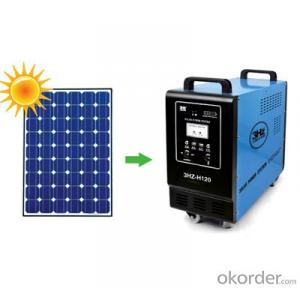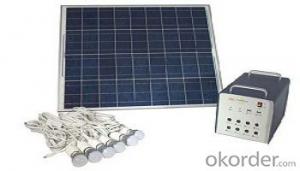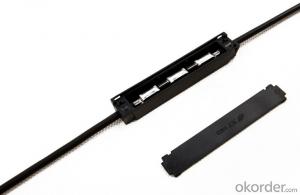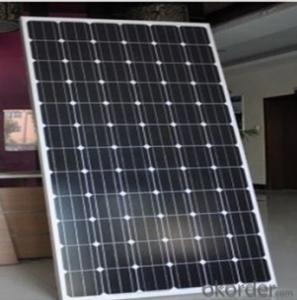Portable solar power generator 150W
- Loading Port:
- China Main Port
- Payment Terms:
- TT OR LC
- Min Order Qty:
- -
- Supply Capability:
- -
OKorder Service Pledge
OKorder Financial Service
You Might Also Like
Specifications
1, 150W Solar Power System.
2, Power rating 300W for home devices.
3, Life span: 15 years.
4, Warranty: 12 months.
150W Solar Power System
1. Functions:
1) This model equipts with high efficiency charge and discharge controlling, over current protection.
2) Direct current output
a. Four plug contacts of DC12V / 20A output, could be used for DC lamp, DC fan, DC refrigerator, etc.
b. With DC9V / 30A and DC5.5V / 500mA output, could be used to charge cell phone, digital camera, music players, etc.
3) Alternating current output
Pure sine wave in 50Hz, continuous power 300W, peak power 600W, could be used to run household appliances like television, computer, fan, icebox, lights, etc.
4) LCD indicator
Showing battery voltage, battery capacity, charging current, inverter working states.
2. System configuration:
1) Poly or mono solar pane: 18V / 150W, 15 years lifespan.
2) Maintenance-free lead-acid batteries can be deep-discharge. 80AH, 12V, three-year lifespan.
3)Pure sine wave inverter. Input: 300W, output: AC 220V / 50Hz.
4) Controller: 12V, 20A
3. User manual:
1) Install the solar panel properly, and connect the solar panel by plug in ‘solar input’on the control box.
2) Operation panel manual
a. Controller’s working states will be showed on the LCD. First line: battery voltage. Second line: charging current. Third line: current battery volume. Fourth line: inverter’s working status.
b. Switch ‘power’ on to start controller, every output outlet works properly.
c. Start AC 220V output by switch ‘inverter’ on, which is fit for AC electrical appliances within 300W. Can be used for most of the digital products through an adapter.
d. It is recommended turning off the back screen light if you don’t need it by press ‘LCD Backlight, this will help to save the power.
4. Notes:
1) Output voltage and current are marked on the panel, overload is prohibited.
2) Keep this product away from rain or water.
3) Charge the battery for 24 hours before the first use, or the product may not work properly for running out of battery during long distance transportation.
3) When you got this product, please fully charge the battery before using. It may not work since over-discharge in long time transportation.
4) To change the battery, please note the battery cable prohibit reverse. Correct wiring should be: the red line connect with the battery anode, black one connects with the battery negative.
5) Please read this manual carefully before using
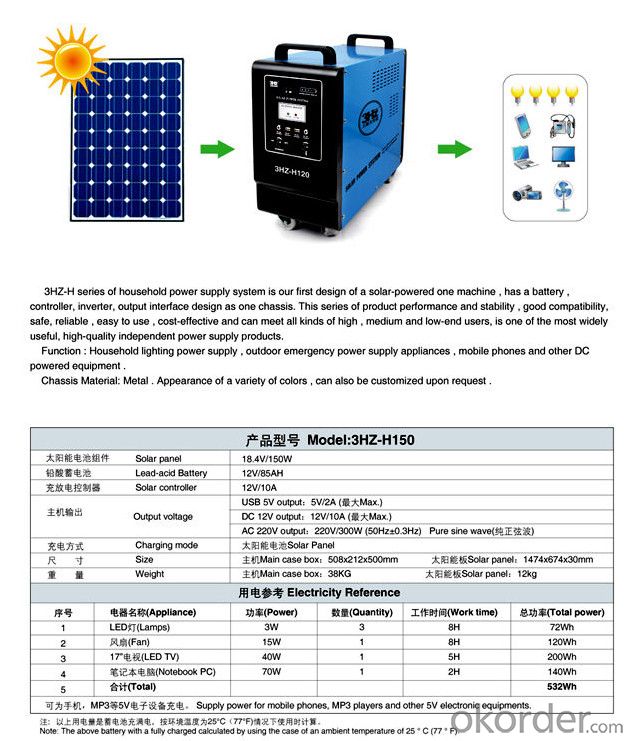
- Q:How do solar energy systems impact energy independence in rural areas?
- Solar energy systems have a significant positive impact on energy independence in rural areas. By harnessing the power of the sun, these systems provide a reliable and sustainable source of electricity that is independent of the traditional power grid. This reduces dependence on fossil fuels and centralized energy distribution, allowing rural communities to generate their own clean energy. Solar energy systems enable rural areas to become self-sufficient and less vulnerable to power outages, price fluctuations, and supply disruptions, thus promoting energy independence and resilience.
- Q:How do solar energy systems contribute to reducing the risk of power outages during extreme weather events?
- Solar energy systems can help reduce the risk of power outages during extreme weather events by providing a decentralized and reliable source of electricity. Since solar panels generate electricity directly from sunlight, they are not dependent on the traditional power grid, which is vulnerable to damage during storms or other severe weather conditions. By harnessing solar energy, individuals and communities can maintain access to power even when the main grid fails, reducing the impact of power outages and increasing resilience during extreme weather events.
- Q:Can a solar energy system be used in areas with high humidity?
- Indeed, areas with high humidity can make use of a solar energy system. Although high humidity can have an impact on the functionality of a solar energy system to some degree, contemporary solar panels are engineered to endure diverse weather conditions, including high humidity. While the efficiency of solar panels may slightly decline in the presence of high humidity due to the moisture in the air, it is not a substantial factor that would render solar energy systems inefficient. Moreover, adequately maintaining and cleaning the panels can alleviate any possible problems caused by humidity. In conclusion, areas with high humidity can still effectively employ solar energy systems.
- Q:What is the role of solar energy systems in reducing stormwater runoff?
- Solar energy systems can play a significant role in reducing stormwater runoff by providing alternative sources of energy that can power water management systems. These systems can be used to pump and treat stormwater, reducing the volume and pollution that would otherwise flow into water bodies. Additionally, solar panels can be installed on rooftops and parking lots, replacing impervious surfaces and allowing rainwater to infiltrate the ground, thus minimizing runoff.
- Q:Can solar energy systems be used in powering beauty salons or spas?
- Certainly, beauty salons and spas can utilize solar energy systems to effectively power their establishments. Solar energy is a source of power that is both renewable and sustainable, enabling these establishments to decrease their reliance on traditional electricity and minimize their carbon footprint. Installation of solar panels on the rooftop or other suitable areas allows beauty salons and spas to generate their own electricity, resulting in long-term cost savings. Beauty salons and spas typically have high electricity requirements for operating various equipment such as hair dryers, hair straighteners, curling irons, lighting, and air conditioning. Solar energy systems are capable of meeting these power demands, particularly during daylight hours when the sun is shining. Any excess electricity generated during the day can be stored in batteries or directed back into the grid, ensuring a continuous and reliable power supply. Furthermore, by adopting solar power, beauty salons and spas can enhance their sustainability and environmental performance. This transition to solar energy enables these establishments to significantly reduce their carbon emissions and actively contribute to the global fight against climate change. Additionally, the use of solar energy can attract environmentally conscious customers who value businesses that prioritize sustainability. To summarize, solar energy systems present a viable solution for powering beauty salons and spas. They provide a dependable and sustainable source of electricity, while also offering cost savings and supporting greener and more environmentally friendly business practices.
- Q:Can solar energy systems be used in powering printing presses or publishing houses?
- Printing presses and publishing houses can be powered using solar energy systems. Solar panels can harness the renewable and sustainable power of the sun and convert it into electricity. This electricity can then be used to operate various equipment found in publishing houses, including printing presses, computers, and machinery. By installing solar panels on the rooftops of these facilities, a significant amount of electricity can be generated. This reduces the need for traditional energy sources and lowers utility costs. The size of the solar energy system required will depend on the specific energy demand of the facility, but it is entirely feasible to power printing presses and publishing houses with solar energy. Solar energy systems also provide a reliable and consistent source of power, as long as there is sufficient sunlight available. This is especially advantageous in regions with abundant sunlight, as the facilities can potentially become self-sufficient in terms of electricity generation. Furthermore, utilizing solar energy systems for powering printing presses and publishing houses has environmental benefits. Solar power is a clean energy source that produces no greenhouse gas emissions or air pollution during operation. By switching to solar energy, these facilities can significantly reduce their carbon footprint and contribute to a more sustainable future. In conclusion, solar energy systems offer a renewable, sustainable, and environmentally friendly alternative for powering printing presses and publishing houses. They provide the potential for cost savings, energy independence, and a reduced carbon footprint.
- Q:Can solar energy systems be used in powering dental clinics or medical clinics?
- Yes, solar energy systems can be used to power dental clinics or medical clinics. Solar panels can be installed on the roofs of these facilities to capture sunlight and convert it into electricity, which can be used to meet their energy needs. This not only helps to reduce their reliance on fossil fuels but also provides a clean and sustainable source of power. Additionally, solar energy systems can be designed to store excess energy for use during non-sunlight hours, ensuring a continuous power supply for critical medical equipment and operations.
- Q:How often do solar panels need to be cleaned?
- Solar panels generally need to be cleaned at least once or twice a year to ensure optimal performance. However, the frequency of cleaning can vary depending on factors such as the local climate, amount of dust or debris accumulation, and the tilt angle of the panels. Regular inspections and maintenance can help determine the specific cleaning needs of solar panels.
- Q:Can solar energy systems be used for powering shopping malls?
- Yes, solar energy systems can definitely be used for powering shopping malls. Solar panels can be installed on the rooftops or parking lots of shopping malls to harness the energy from the sun. This energy can then be converted into electricity, which can power various operations within the mall, including lighting, heating and cooling systems, escalators, elevators, and other electrical appliances. By utilizing solar energy, shopping malls can significantly reduce their dependence on traditional energy sources and lower their carbon footprint. Additionally, solar energy systems can help malls save on electricity costs in the long run, as they generate clean and renewable energy. Overall, solar energy systems are a viable and sustainable option for powering shopping malls.
- Q:Can solar energy systems be integrated into building design?
- Building design can include the integration of solar energy systems. This approach is increasingly popular and is considered both sustainable and cost-effective for generating electricity. There are multiple ways to incorporate solar energy systems, such as using rooftop solar panels, solar facades, or solar windows. The most common method is installing rooftop solar panels. These can be standalone structures or integrated into the roof itself. They capture sunlight and convert it into electricity, which can power the building or be fed back into the grid. Solar facades are another option. These involve placing solar panels on the outer walls of buildings. Besides generating electricity, they also act as a protective layer, reducing heat gain and improving energy efficiency. Solar windows are a new development in building design. These windows have built-in transparent solar cells that capture sunlight and generate electricity while still allowing natural light to enter the building. They have the potential to revolutionize building design by seamlessly integrating renewable energy generation into the building envelope. Integrating solar energy systems into building design offers several advantages. Firstly, buildings can generate their own electricity, reducing reliance on fossil fuels and lowering utility bills. This also contributes to reducing greenhouse gas emissions and creating a cleaner environment. Additionally, solar energy systems can enhance the aesthetic appeal of buildings, making them visually striking examples of sustainable architecture. In conclusion, solar energy systems can be integrated into building design. With options like rooftop solar panels, solar facades, and solar windows, buildings can generate clean, renewable electricity, reduce their carbon footprint, and contribute to a more sustainable future.
1. Manufacturer Overview |
|
|---|---|
| Location | |
| Year Established | |
| Annual Output Value | |
| Main Markets | |
| Company Certifications | |
2. Manufacturer Certificates |
|
|---|---|
| a) Certification Name | |
| Range | |
| Reference | |
| Validity Period | |
3. Manufacturer Capability |
|
|---|---|
| a)Trade Capacity | |
| Nearest Port | |
| Export Percentage | |
| No.of Employees in Trade Department | |
| Language Spoken: | |
| b)Factory Information | |
| Factory Size: | |
| No. of Production Lines | |
| Contract Manufacturing | |
| Product Price Range | |
Send your message to us
Portable solar power generator 150W
- Loading Port:
- China Main Port
- Payment Terms:
- TT OR LC
- Min Order Qty:
- -
- Supply Capability:
- -
OKorder Service Pledge
OKorder Financial Service
Similar products
New products
Hot products
Hot Searches
Related keywords
